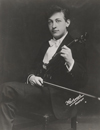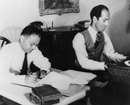All material found in the Press Releases section is provided by parties entirely independent of Musical America, which is not responsible for content.
Press Releases
Small orchestra works to lift up work of Samuel Coleridge Taylor
Media Contact
Johannes Müller Stosch, Music Director, Holland Symphony Orchestra
562-546-2552
jmstosch@gmail.com
Kay Walvoord, President, Holland Symphony Orchestra
616.405.5198
hso@hollandsymphony.org
SMALL ORCHESTRA WORKS TO LIFT UP THE WORK OF 18TH-CENTURY BLACK COMPOSER
HOLLAND, MI - Feb. 6, 2023 – More orchestras have access to an important work by 19th-century Black Composer Samuel Coleridge-Taylor because of the efforts of the Holland Symphony Orchestra.
HSO Music Director Johannes Müller Stosch commissioned a piano version of Coleridge-Taylor’s “Hiawatha Suite” to be composed into a full orchestra score and performed it with the HSO in 2021. Additionally, he made the newly created score available for free for orchestras around the world to perform. As a result, he has heard from orchestras around the country that are interested in performing the piece, and he hopes to get the word out to more classical music organizations. As we celebrate Black History Month, this story is an example of how arts organizations – even those in small communities - can lift up the work of Black musicians.
As a composer, Coleridge-Taylor “sought to draw from traditional African music and integrate it into the classical tradition, which he considered Johannes Brahms to have done with Hungarian music and Antonín Dvorák with Bohemian music,” according to blackmozart.org.
Creating access to the work
While his music was wildly popular in the late 1800s and early 1900s, it didn’t make it across the years. With the exception of William Grant Still, few Black composers are part of the canon of work performed by today’s orchestras.
“There are some composers that did enter the canon for some reason,” Stosch says. “And I would say more composers of color didn't. And so it's great that these parts exist and that we're now shining a light on all this repertoire that needs to be done.”
He credits the diversity, equity and inclusion movement for creating interest in the classical music world in bringing diversity to programming. But for that to happen, these pieces need to be listed in anthologies and the parts need to be available.
"It's wonderful to see an important work like Samuel Coleridge-Taylor's ‘Hiawatha Suite’ infuse orchestra programs," said Simon Woods, President and CEO of the League of American Orchestras. "Johannes Müller Stosch and the Holland Symphony Orchestra are providing a great service by helping to make this music accessible to the orchestra field."
As the HSO, one of Holland’s oldest music organizations, commits to being more diverse and inclusive, it is exploring why more music of non-white composers is not being performed and looking for ways to address the issue. Introducing today’s audience to the work of Coleridge-Taylor is a step toward that goal.
You can watch HSO’s performance of the ‘Hiawatha Suite' here.
How HSO revived ‘Hiawatha’
For several years, HSO’s artistic team has been adding the music of underrepresented composers to the HSO concerts. Stosch programmed a work by Coleridge-Taylor for the HSO’s fall concert on Oct. 16, 2021. Coleridge-Taylor was an English composer influenced by Edward Elgar. During three successful tours of the United States, he was often compared to Dvorak or Mahler.
The “Hiawatha Suite,” which HSO performed, came from one of his greatest successes, a cantata called “Hiawatha’s Wedding Feast.” Coleridge-Taylor was also a conductor and created a recording of this suite using a piano score—a simplified score that looks like a piano part, with only occasional indications of which instrument plays any specific part. The 1920 recording, available on YouTube, is so scratchy that it is hard to hear. Until the HSO shared its concert on YouTube, this was the only available recording of the work.
As HSO considered this work for a future concert, the parts had just become available due to the expiration of the copyright restrictions. No full score existed—only the piano reduction, and the absence of a full score was a serious obstacle to performance. Stosch contracted a former student from his university, California State University in Long Beach, to produce a full score from all the individual instrumental parts. This mammoth undertaking took dedication and many hours of work. His university and HSO shared the cost.
The score and refined parts were then made available online — free — for any orchestras to use. The live recording made at the HSO concert was shared on YouTube, providing conductors the ability to look at the score while hearing a matching recording. Removing these kinds of barriers is an important step toward making this literature more accessible for future programming.
The HSO and Stosch therefore added this underplayed, interesting composition by a composer of color to the symphonic canon.





 FEATURED JOBS
FEATURED JOBS

 RENT A PHOTO
RENT A PHOTO


